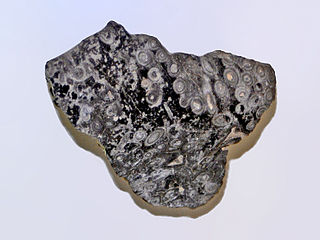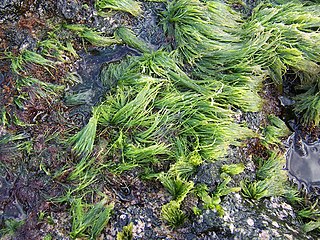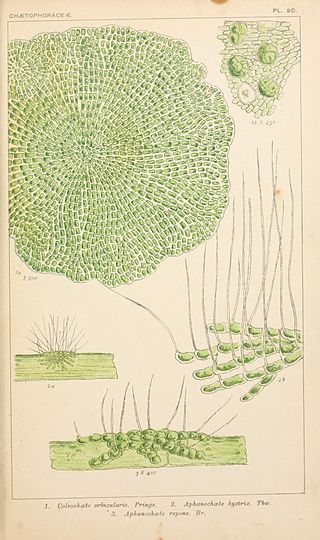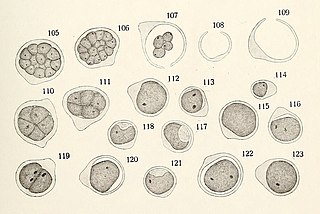
The glaucophytes, also known as glaucocystophytes or glaucocystids, are a small group of unicellular algae found in freshwater and moist terrestrial environments, less common today than they were during the Proterozoic. The stated number of species in the group varies from about 14 to 26. Together with the red algae (Rhodophyta) and the green algae plus land plants, they form the Archaeplastida.

Charales is an order of freshwater green algae in the division Charophyta, class Charophyceae, commonly known as stoneworts. Depending on the treatment of the genus Nitellopsis, living (extant) species are placed into either one family (Characeae) or two. Further families are used for fossil members of the order. Linnaeus established the genus Chara in 1753.

AlgaeBase is a global species database of information on all groups of algae, both marine and freshwater, as well as sea-grass.

Eustigmatophytes are a small group of eukaryotic forms of algae that includes marine, freshwater and soil-living species.

The Trebouxiophyceae, also known as trebouxiophytes, are a class of green algae, in the division Chlorophyta. Members of this class are single-celled, colonial, or multicellular and are found in freshwater or terrestrial habitats worldwide. Many taxa in the Trebouxiophyceae form symbiotic relationships with other organisms; in particular, the majority of phycobionts within lichens are trebouxiophytes. A number of taxa have also lost the ability to photosynthesize, and have evolved to become parasitic; examples include Prototheca and Helicosporidium.

Bryopsidales is an order of green algae, in the class Ulvophyceae.

The Dasycladaceae is one of the two extant families of green algae of the order Dasycladales. When found in Palaeozoic limestones, they typically indicate depositional depth of less than 5m.

Chaetomorpha is a genus of green algae in the family Cladophoraceae. Members of this genus may be referred to by the common name sea emerald.

Hormotila is a genus of green algae in the family Chaetophoraceae.
Pleurastrum is a genus of green algae, specifically of the Chlorophyceae. As of February 2022, it was the only genus in the family Pleurastraceae.

Bambusina is a genus of freshwater green algae in the family Desmidiaceae. Bambusina is a cosmopolitan genus, typically associated with acidic and oligotrophic waters. Species of this genus, particularly B. borreri, have been reported in all continents except Antarctica.

Sykidion is a genus of green algae. Pseudoneochloris is a synonym of this genus. As of March 2022, Sykidion was the only genus in the family Sykidiacaeae, which was the only family in the order Sykidiales.

Palmodictyon is a genus of green algae in the family Radiococcaceae.

Chlorokybus is a multicellular (sarcinoid) genus of basal green algae or charophyte. It has been classified as the sole member of the family Chlorokybaceae, which is the sole member of the order Chlorokybales, in turn the sole member of the class Chlorokybophyceae. It grows on soil and rock surfaces, and is rare.
Mesostigma is a genus of unicellular biflagellate freshwater green algae, with a single species Mesostigma viride, covered by an outer layer of basket‐like scales instead of a cell wall. It is the only known genus in the class Mesostigmatophyceae.

Coleochaetaceae is a family of algae. It is the only family in the Coleochaetales, an order of parenchymous charophyte algae, within the class Coleochaetophyceae. It includes some of the closest multicellular relatives of land plants. It contains the genus Coleochaete and questionably includes the fossil genus Parka.
Pyrenomonas is a genus of cryptomonad.

Chorda is a genus of thalloid brown algae. It is the only genus in the family Chordaceae. Its members are known by a number of common names including: mermaid's fishing line, tsurumo, ruálach, doruithe briain, sailors' laces, sea laces, mermaids line, roccálach, ruadhálach, gemeine meersaite, bootlace weed, seatwine, zottige meersaite, dead men's ropes, mermaid's tresses, cat gut and sea lace.

Myrmecia is a genus of green algae that is associated with lichens.
Ilsteria is a genus of algae from the yellow-green algae class. It is a colonial organism, generally consisting of four or – sometimes – two cells. This genus is named after a Latvian botanist, teacher and poet Jānis Ilsters (1851–1889).
















